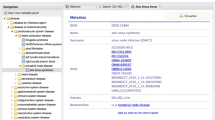Abstract
Integration of disease databases benefits physicians searching for disease information. However, current algorithmic matching is not sufficiently powerful to automate the integration process. This paper reports our attempt to manually integrate disease entries spread across public disease databases, Online Mendelian Inheritance in Man and Orphanet, with a proprietary disease knowledge base. During the process, we identified that relations between synonyms require special handling, and a set of resolution rules are proposed. Situations encountered throughout the integration suggested that variations in the cross-references would facilitate future integration of distinct disease databases.
Access this chapter
Tax calculation will be finalised at checkout
Purchases are for personal use only
Preview
Unable to display preview. Download preview PDF.
Similar content being viewed by others
References
Belleau, F., Nolin, M.A., Tourigny, N., Rigault, P., Morissette, J.: Bio2RDF: towards a mashup to build bioinformatics knowledge systems. Journal of Biomedical Informatics 41(5), 706–716 (2008)
Bodenreider, O.: The unified medical language system (UMLS): integrating biomedical terminology 32, D267–D270 (2004)
Miličić Brandt, M., Rath, A., Devereau, A., Aymé, S.: Mapping orphanet terminology to UMLS. In: Peleg, M., Lavrač, N., Combi, C. (eds.) AIME 2011. LNCS, vol. 6747, pp. 194–203. Springer, Heidelberg (2011)
Chen, B., Dong, X., Jiao, D., Wang, H., Zhu, Q., Ding, Y., Wild, D.J.: Chem2Bio2RDF: a semantic framework for linking and data mining chemogenomic and systems chemical biology data. BMC bioinformatics 11(1), 255 (2010)
Doan, A., Halevy, A.Y.: Semantic integration research in the database community: A brief survey. AI magazine 26(1), 83 (2005)
Euzenat, J., Shvaiko, P., et al.: Ontology matching, vol. 18. Springer (2007)
INSERM SC11: Orphanet. http://www.orpha.net/
John Hopkins University: OMIM: Online Mendelian Inheritance in Man. http://www.ncbi.nlm.nih.gov/omim
Merabti, T., Joubert, M., Lecroq, T., Rath, A., Darmoni, S.: Mapping biomedical terminologies using natural language processing tools and UMLS: mapping the Orphanet thesaurus to the MeSH. BioMedical Engineering and Research 31(4), 221–225 (2010)
Morita, M., Igarashi, Y., Ito, M., Chen, Y.A., Nagao, C., Sakaguchi, Y., Sakate, R., Masui, T., Mizuguchi, K.: Sagace: A web-based search engine for biomedical databases in japan. BMC research notes 5(1), 604 (2012)
National Center for Biotechnology Information, National Library of Medicine: PubMed. http://www.ncbi.nlm.nih.gov/pubmed/
National Library of Medicine: Medical Subject Headings. http://www.nlm.nih.gov/mesh/
Noy, N.F.: Semantic integration: a survey of ontology-based approaches. ACM SIGMOD Record 33(4), 65–70 (2004)
Okumura, T., Tanaka, H., Omura, M., Ito, M., Nakagawa, S., Tateisi, Y.: Cost decisions in the development of disease knowledge base : A case study. In: 2014 International Workshop on Biomedical and Health Informatics, November 2014
Rance, B., Snyder, M., Lewis, J., Bodenreider, O.: Leveraging Terminological Resources for Mapping between Rare Disease Information Sources. Studies in health technology and informatics 192, 529 (2013)
Tokuda, Y., Aoki, M., Kandpal, S.B., Tierney, L.M.: Caught in the web: E-diagnosis. Clinical Care Conundrums: Challenging Diagnoses in Hospital Medicine, pp. 169–175 (2013)
World Health Organization: ICD-10: International statistical classification of diseases and related health problems. World Health Organization (2011)
Author information
Authors and Affiliations
Corresponding author
Editor information
Editors and Affiliations
Rights and permissions
Copyright information
© 2015 Springer International Publishing Switzerland
About this paper
Cite this paper
Ito, M., Nakagawa, S., Mizuguchi, K., Okumura, T. (2015). Integration of Disease Entries Across OMIM, Orphanet, and a Proprietary Knowledge Base. In: Ali, M., Kwon, Y., Lee, CH., Kim, J., Kim, Y. (eds) Current Approaches in Applied Artificial Intelligence. IEA/AIE 2015. Lecture Notes in Computer Science(), vol 9101. Springer, Cham. https://doi.org/10.1007/978-3-319-19066-2_12
Download citation
DOI: https://doi.org/10.1007/978-3-319-19066-2_12
Published:
Publisher Name: Springer, Cham
Print ISBN: 978-3-319-19065-5
Online ISBN: 978-3-319-19066-2
eBook Packages: Computer ScienceComputer Science (R0)




